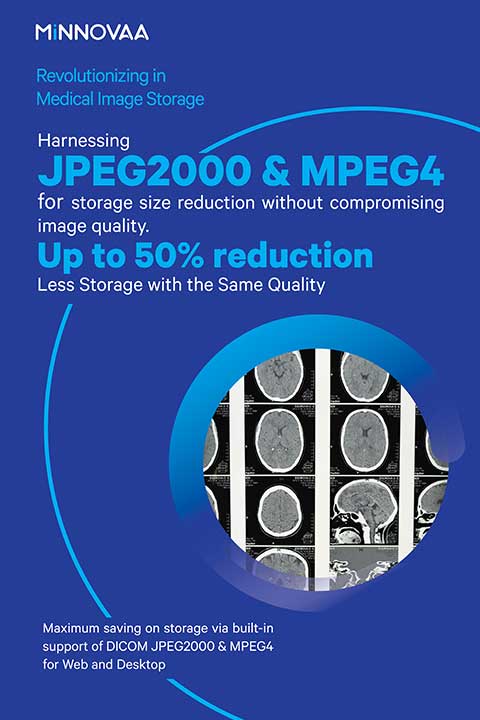In recent years, the field of medical imaging has witnessed significant advancements in image compression and transmission protocols. Two prominent technologies, JPEG 2000 and MPEG4, have played a pivotal role in revolutionizing the way medical images are stored, transmitted, and viewed. This article explores the impact of these protocols on reducing the file size of medical images while preserving their quality. Additionally, it delves into how Picture Archiving and Communication Systems (PACS) can leverage these protocols, and how DICOM viewers supporting this technology can benefit imaging facilities by reducing storage costs.
JPEG 2000 and MPEG4: A Brief Overview
JPEG 2000 and MPEG4 are industry-standard compression algorithms designed to efficiently handle various types of visual data, including images and videos.
JPEG 2000 excels in maintaining high image quality while achieving substantial compression ratios. It employs advanced wavelet-based techniques and offers lossless and lossy compression options. This makes it particularly well-suited for medical images, where retaining fine details is crucial for accurate diagnosis.
MPEG4, on the other hand, is a versatile compression standard primarily known for its efficiency in compressing video sequences. It utilizes various compression techniques, including motion compensation and transform coding, making it suitable for both moving images and still frames. MPEG4’s adaptability and high compression rates make it an excellent choice for medical video data.
Impact on Medical Imaging
Reduced File Sizes, Preserved Quality:
Both JPEG 2000 and MPEG4 have demonstrated remarkable capabilities in reducing the file size of medical images and videos. This reduction is achieved without compromising the critical diagnostic information present in the images. This is particularly significant in scenarios where storage space is limited or expensive.
PACS Integration:
Modern PACS systems have the capability to support various compression protocols, including JPEG 2000 and MPEG4. By implementing these protocols, PACS can efficiently manage and store a larger volume of medical images, optimizing storage resources. This not only reduces costs associated with storage but also enhances the overall efficiency of the system.
Benefits of DICOM Viewers:
DICOM viewers that incorporate support for JPEG 2000 and MPEG4 offer a range of advantages to imaging facilities. These viewers facilitate rapid loading and processing of images, leading to improved workflow efficiency. Additionally, they enable seamless access to high-quality images, even in low-bandwidth environments, which is particularly beneficial for remote or mobile diagnostic scenarios.
MiNNOVAA’s Innovative Use of JPEG 2000 and MPEG4 Technologies
MiNNOVAA’s medical imaging solutions stand out through their effective utilization of JPEG 2000 and MPEG4 technologies. These technologies are at the core of the PACS system – NOVEL, where they are employed to compress and store images on the PACS server in a significantly reduced volume. When compared to other solutions, NOVEL requires only half the usual storage space for storing a specified amount of medical images. This translates to financial savings and provides imaging centers with greater flexibility for expansion.

Furthermore, both web and desktop viewers in MiNNOVAA’s offerings are equipped to support this technology. This ensures seamless display and processing of images with this new structure. As a result, the loading speed of images on the web platform experiences a remarkable boost in comparison to larger file sizes.
Conclusion
The integration of JPEG 2000 and MPEG4 compression protocols in medical imaging has revolutionized the way images are stored, transmitted, and viewed. These technologies have significantly reduced file sizes while maintaining diagnostic quality, making them invaluable tools in the healthcare industry. Through their implementation in PACS systems and DICOM viewers, medical facilities can optimize storage resources, enhance workflow efficiency, and provide timely access to critical imaging data. As the field of medical imaging continues to evolve, the role of compression protocols like JPEG 2000 and MPEG4 will undoubtedly become even more central in ensuring high-quality patient care.
